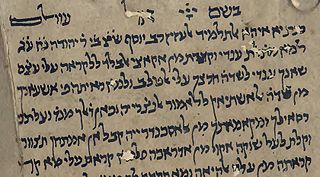You can help expand this article with text translated from the corresponding article in Hebrew. (July 2019) Click [show] for important translation instructions.
|
| Medieval Hebrew | |
|---|---|
| עִבְרִית Ivrit | |
 Excerpt from 13th–14th-century manuscript of the Hebrew translation of The Guide for the Perplexed | |
| Region | Jewish diaspora |
| Era | Academic language used from the death of Hebrew as a spoken language in the 4th century until its revival as a spoken language in the 19th century. Developed into Modern Hebrew by the 19th century |
Early forms | |
| Hebrew abjad | |
| Language codes | |
| ISO 639-3 | – |
| Glottolog | None |

Medieval Hebrew was a literary and liturgical language that existed between the 4th and 19th century. It was not commonly used as a spoken language, but mainly in written form by rabbis, scholars and poets. Medieval Hebrew had many features distinguishing it from older forms of Hebrew. These affected grammar, syntax, sentence structure, and also included a wide variety of new lexical items, which were either based on older forms or borrowed from other languages, especially Aramaic, Koine Greek and Latin.[1]
- ^ Encarta-encyclopedie Winkler Prins (1993–2002) s.v. "Hebreeuwse taal. §1. Oud-Hebreeuws en Midden-Hebreeuws". Microsoft Corporation/Het Spectrum.